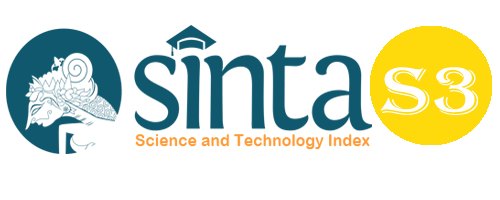The Effect of Knowledge Management, Employee Engagement, and Intrinsic Motivation on Employee Performance with Organizational Culture as a Moderating Variable
Abstract
This study aims to obtain an overview of how the influence of knowledge management, employee involvement, and intrinsic motivation is moderated by organizational culture on employee performance. This study uses an associative quantitative approach using regression techniques. The sample of this study amounted to 199 people where the majority consisted of employees engaged in services (46.7%) and trade & manufacturing (22.1%). Research data was collected through a questionnaire instrument designed using a Likert scale which was first tested for validity and reliability. Based on the research results, there is a positive and significant influence of knowledge management and intrinsic motivation on employee performance. Otherwise, there is no positive and significant effect of employee engagement on employee performance. Meanwhile, organizational culture cannot be used as a moderating variable to improve employee performance because of the dominance of this variable on employee performance. This finding shows that if an organization wants to improve the performance of its employees, it can be done by implementing optimal knowledge management and providing consistent intrinsic motivation.
Keywords
Full Text:
PDFReferences
Akanbi, PA (2011). “Influence of extrinsic and intrinsic motivation on employees' performance”. Oyo State: Ajayi Crowther University.
Akbar, FN (2012), “The Influence of Intrinsic Motivation and Extrinsic Motivation on Employee Performance at PT Perkebunan Nusantara XII Surabaya”, Malang: FEB Universitas Brawijaya.
Anitha, J. (2014).”Determinants of employee engagement and their impact on employee performance”, IJPPM, Vol. 63, No. 3, pp. 308-323
Ayub, N. & Islam, MK (2018).”The effects of employee engagement on employee performance in the hotel industry in Kelantan”, Global Business and Management Research: An International Journal, Vol. 10, No. 3, pp. 828-838.
Chandra, C. & Remiasa, M. (2018). “The effect of employee engagement on employee performance at PT Intiland Grande, AGORA, Vol. 6, No. 1.
Coon, D. & Mitterer, JO 2010. Introduction to psychology: Gateways to mind and behavior with concept maps. Belmont, CA: Wadsworth.
Dernovsek D. (2008). Creating highly engaged and committed employee starts at the top and ends at the bottom line Credit Union Magazine, May 2008. Credit Union National Association, Inc.
Dicke, Holwerda, & Kontakos. (2007).”Employee engagement: What do we really know? what do we need to know take action”. Paris: Center for Advanced Human Resource Studies (CAHRS).
gallup. (2013). How Employee Engagement Drives Growth. Business Journal. Retrieved March 11,2016,from:http://www.gallup.com/businessjournal/163130/employee-engagementdrves-growth.aspx
Garg, P., Rastogi, R. (2006), "New model of job design: motivating employees performance", Journal of Management Development, Vol. 25, No. 6, pp. 572-587.
Gunawan, H. & Wardana, AW (2018) "Knowledge sharing as a mediation between employee engagement and the performance of Gojek drivers in Yogyakarta", Mercu Buana University Yogyakarta, Vol. 3, No. 4, pp. 411-424.
Hamdani, Mulyanti, RY, Abdillah, F. (2019), “The influence of intrinsic and extrinsic motivation on the performance of Grabbike drivers”, Ecobis Journal: Economics, Business and Management, Vol. 9, No. 2, pp. 89-103.
Hwang, DY, Lin, YC, & Lyu, J. 2008. The Performance Evaluation of SCOR Sourcing Process—The Case Study of Taiwan's TFT-LCD Industry. International Journal of Production Economics. 115: 411– 423.
Iqbal N et al. 2013. Impact of performance appraisal on employee's performance involving the moderating role of motivation. Arabian Journal of Business and Management Review 3(1): 37–56.
Islam, R., Ismail, AZH (2008), "Employee motivation: a Malaysian perspective", International Journal of Commerce and Management, Vol. 18, No. 4, pp. 344-362.
Kahn, WA (1990). “Psychological conditions of personal engagement and disengagement at work”, Academy of Management Journal, Vol. 33, No. 4, pp. 692-724.
Luthans, F. (2011). "Organizational Behavior: An Evidence-Based Approach". New York: McGraw-Hill.
Macey, WH & Schneider, B. (2008). “The meaning of employee engagement”, Industrial and Organizational Psychology, Vol. 1, No. 1, pp. 3-30.
Macey, WH, Schneider, B., Barbera, KM & Young, SA (2009) “Employee Engagement: Tools for Analysis, Practice, and Competitive Advantage”.
Malik S et al. 2014. Impact of Performance Appraisal on Employee Performance. Journal of Resources Development and Management 3(1): 23.
Markos, S., & Sridevi, MS (2010). Employee Engagement: The Key To Improving Performances. International Journal of Business and Management, 5 No. 12, 89-96.
Munparidi & Sayuti, AJ (2020) "The effect of employee engagement on employee performance through job satisfaction as a mediating variable", Journal of Management and Business Applications, Vol. 1, No, 1, pp. 36-46.
Nkeobuna, John. 2020. Performance Appraisal and its Effect on Employees' Productivity in Charitable Organizations. Business, Management and Economics Research Vol. 6, Issues. 12, pp: 166-175.
Pradana, M. & Aisyah, F. (2020) "The effect of employee engagement on employee performance in the parent unit of the West Kalimantan region PT (Persero) the State Electricity Company", Telkom University, Vol. 7, No. 2, pp. 6411-6420.
Prahiawan, W., Simbolon, N. (2014), "The influence of intrinsic motivation and work environment on employee performance at PT Intimas Lestari Nusantara", Journal of Economics, Vol. 5, No. 1, pp. 35-41.
Putra, AK (2013), “The influence of intrinsic motivation and extrinsic motivation on job satisfaction (Case Study of PT Semen Gresik Persero)”, Journal of Management Science, Vol. 1, No. 1, pp. 377-387.
Rich, BL, et. al. (2010), “Job engagement: antecedents and effects on job performance”, Academy of Management Journal, Vol. 53, No. 3, pp. 617-635.
Robbins, SP & Judge, TA (2015). "Organizational behavior". Jakarta: PT Salemba Empat.
Schaufeli, WB, Bakker, AB, & Salanova, M. (2006). “The measurement of work engagement with a short questionnaire: A cross-national study”. Educational and psychological measurement, Vol. 66, pp. 701 – 716.
Schaufeli, WB, et. al. (2002). “The measurement of engagement and burnout: a two sample confirmatory factor analytic approach”, Journal of Happiness Studies, Vol. 3,No. 1, pp. 71-92.
Sendawula, K. et. al. (2018). “Training, employee engagement and employee performance: Evidence from Uganda's health sector”, Cogent Business & Management.
Setyawan, J., Rusdianti, E. and Widhiastuti, H. (2021). "The effect of satisfaction, compensation and teamwork on employee performance is mediated by employee engagement", Journal of Economics and Business Research, Vol. 14, No. 2, pp. 133-143.
Sharma, BR & Anupama R. (2010) “Determinants of Employee Engagement in a Private Sector Organization: An Exploratory Study”, Advances in Management, Vol.3, No.10, pp. 52-59.
Sulistiyani and Rosidah (2003). "Human Resource Management". Yogyakarta: Graha Ilmu.
Suwatno, Priansa, D. (2011). "HR Management in Public and Business Organizations". Bandung: Alphabeta.
Tajuddin, Sukma Juwati. 2012. The Effect of Employee Performance Assessment on Career Development at PT Semen Tonasa Pangkep Regency. Thesis is not published. Makassar: Hasanuddin University.
Wahyu, H., Agnes & Setiawan, R. (2017) “The effect of employee engagement on employee performance at PT Tirta Rejeki Dewata, AGORA, Vol. 5, No. 1.
Yannizar, et al. (2020). Analysis of Good Corporate Governance, Free Cash Flow, Leverage towards Earning Management, and Shareholder Wealth in Service Sector Companies Listed on the Indonesia Stock Exchange. Budapest International Research and Critics Institute-Journal (BIRCI-Journal).P. 2567j-2567v.
DOI: https://doi.org/10.33258/birci.v4i4.3491
Article Metrics
Abstract view : 185 timesPDF - 91 times
Refbacks
- There are currently no refbacks.

This work is licensed under a Creative Commons Attribution-ShareAlike 4.0 International License.

This work is licensed under a Creative Commons Attribution-ShareAlike 4.0 International License.

_.gif)

















_.gif)



